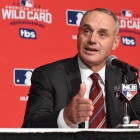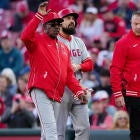Earlier this week, after rampant speculation and reporting that there could be a lockout, the owners and Major League Baseball Players Association agreed upon a new collective bargaining agreement. We've already heard about several of the major details (no international draft, World Series home-field advantage determined by best record, etc.), but Friday the league released the full document.
So let's peruse the 16 sections and come up with the points that may be of interest:
- This is a five-year deal, so we won't see an interrupted MLB season due to a labor dispute until 2022 at the very earliest.
- The regular season has been lengthened to give the players four extra off-days.
- World Series home-field advantage is assigned to the team with the best record, not the league winning the All-Star Game.
- The 15-day disabled list is now the 10-day disabled list.
- The number of All-Stars that used to be selected by the manager will now go to the commissioner's office. So there's a fan vote for the starters, players vote for primary backups and then the remaining spots go to MLB instead of the manager of each particular league.
- The big news in the revenue sharing system is that the number of "market disqualified clubs" (i.e. teams playing in markets too large to get revenue sharing money) is reduced with the A's being phased out over a four-year period beginning in 2017. Keep in mind that Oakland is actually in a large market (the Bay Area), but they don't exactly have large-market circumstances.
- The competitive balance tax thresholds will be $195 million in 2017, $197 million in 2018, $206 million in 2019, $208 million in 2020, and $210 million in 2021. Teams exceeding these player salary figures will be taxed 20 percent for first-timers, 30 percent the second time and fifty percent for third- or more timers. So while the figure it high, it seems pretty reasonable that a team isn't going to want to be over $210 million three straight seasons and, in turn, slapped with a $100 million tax.
There are additional taxes for being $20M and then $40M over the threshold. Further, teams being $40 million or more over the threshold will have their highest selection in the MLB Draft moved back 10 spots, assuming it's not a pick in the top six (in which case it would be the second pick that is moved back).
-Instead of seven days, a player now has 10 days to accept a qualifying offer. Also, if a player has previously gotten a qualifying offer, he can't get another (for example, the Phillies can't offer one to Jeremy Hellickson again next offseason).
- Smaller market teams will forfeit their third-highest MLB draft pick to sign a player who declined a qualifying offer. Larger market teams will forfeit their second- and fifth-highest picks. Those in the middle forfeit their second-highest pick and have their international bonus pool reduced by $500,000 next season.
- The league minimum has increased modestly (from $507.5K to $535K for next season, for example).
- "The parties agreed on an international play plan in which Clubs will stage games or tours in Mexico, Asia, Puerto Rico, the Dominican Republic and London over the next five years in order to grow the game."
- The number of in-season random drug tests has been increased from 3,200 to 4,800, with all players on 40-man rosters subject to random tests during the offseason.
- There's now a smokeless tobacco ban, with all players who saw action in 2016 or earlier grandfathered in.
- In addition to the domestic violence policy remaining intact, there will be anti-hazing and anti-bullying policies.
- The time period in which a club may designate a player for assignment has been reduced from 10 days to seven days.
Most of that is procedural, of course, but it's still important -- or at least it will be when we discuss player moves for the next five years. And, of course, the All-Star Game process is interesting and the home-field advantage in the World Series is a hot button issue.






















